NOMA is renowned for its collection of French art. As the museum opens its doors for a French Fête on Friday, August 9, from 5 – 9 p.m., we invite you to behold the works of Edgar Degas, Auguste Rodin, and Elisabeth Louise Vigée Le Brun, among the many French artists represented in the museum and Besthoff Sculpture Garden. Listed here are ten works not to miss in the galleries. A tour focusing on Degas, upon the occasion of his 185th birthday, will take place at 6 pm.
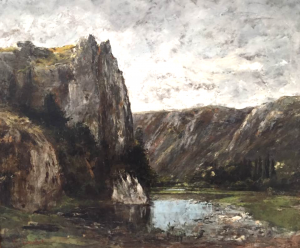
Gustave Courbet, Rocky Landscape, c. 1858, Oil on canvas, Museum Purchase through the Ella West Freeman Foundation Matching Grant, 69.16
Gustave Courbet, Rocky Landscape, c. 1858
Gustave Courbet (1819–1877) became a seminal painter in the nonconformist Realism movement of 19th-century French painting. Rejecting the emotive idealism of Romanticism, Courbet wrote in his 1861 Realist Manifesto that “painting is an essentially concrete art and can only consist in the representation of real and existing things.” His Rocky Landscape depicts the rustic terrain of the region surrounding Flagey, his father’s native village in northeast France. A rebel on both the canvas and in his politics, Courbet was jailed in 1871 for his involvement with the Paris Commune, a radical socialist and revolutionary government that ruled the French capital for ten days following the defeat of the French Second Empire. Courbet was personally blamed for the destruction of the Vendôme Column during the uprising, and a judge ordered him to pay for its reconstruction at a prohibitive cost of more than 300,000 francs. Courbet went into self-imposed exile in Switzerland and died at age 58 within hours of the due date for his first installment payment of 10,000 francs.
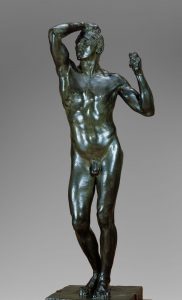
Auguste Rodin, The Age of Bronze, 1875–1876 (modeled), cast during the artist’s lifetime, Bronze, Gift of Mr. and Mrs. Aage Quvistgaard-Peterson, 64.21
Auguste Rodin, The Age of Bronze, 1875–1876
Auguste Rodin (1840–1917) is considered the progenitor of modern sculpture. The Age of Bronze recalls a primal stage of mankind. Belgian soldier Auguste Ney served as the model. At its debut exhibition in Paris, the statue caused a scandal when speculation arose that Rodin had merely used a cast of his model, rather than sculpted the piece—an accusal that stands as a testament to its lifelike detail and realistic proportions. Deemed innocent of the slanderous charges, Rodin quickly rose to fame for his skill in sculpting.

Ilse Bing (German, 1899–1998), Pommery Champagne Bottles, Reims, 1933, Gelatin silver print, Museum purchase, Zemurray Foundation Fund. 76.290
Ilse Bing, Pommery Champagne Bottles, Reims, 1933
Though born in Germany, photographer Isle Bing (1899–1998) spent much of her career in Paris where she became a pioneering avant-garde photographer of the interwar era. She came to be known as the “queen of the Leica,” an advanced camera of the 1930s. Bing’s work was included in the first modern photography exhibition held at the Louvre in 1937. She and her husband, who were both Jews, fled Europe during the rise of Nazism and immigrated to the United States in 1940. This photograph, on view in the exhibition You Are Here: A Brief History of Photography and Place, features dozens of Champagne bottles from Pommery, a brand headquartered in Reims and founded in 1858. Madam Pommery, who led the winery to fame after her husband died a mere six months after purchasing the estate, is credited with turning Champagne from a sweet dessert drink into a dry and crisp liquor (the Brut variation) that can be served before, during, or after a dinner, and commonly associated with celebration. Café NOMA will serve French 75 Champagne cocktails at cash bars within the museum for French Fête.
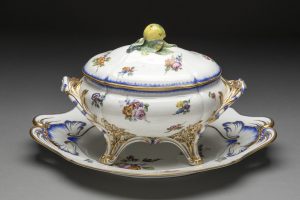
French National Porcelain Manufactory (Vincennes 1740–1756, Sèvres 1756 to present), Designed by Jean-Claude Duplessis (French, c.1695–1774), Painted by Pierre-Joseph Rosset (French, 1734–1799), Covered Tureen and Plate (Terrine du Roi), 1754–1755, Soft-paste porcelain, hand-painted and gilded, Museum purchase, William McDonald Boles and Eva Carol Boles Fund, 2000.53.a–.c
French National Porcelain Manufactory, Covered Tureen and Plate (Terrine du Roi), 1754–1755
This soup terrine exhibits all the qualities of the Rococo style, regarded as the first truly international decorative expression. Rococo originated in the court of Louis XV in the 1730s and for the next thirty years was the reigning fashion in furniture, silver, ceramics, and painting. Rococo is characterized by an elaborately ornamental late baroque style of decoration with asymmetrical patterns involving motifs and scrollwork.
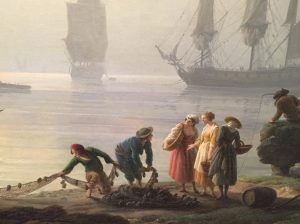
Claude-Joseph Vernet, The Morning Port Scene, detail, 1780, Oil on canvas, Museum purchase and gift of Edith Rosenwald Stern and Muriel Bultman Francis, by exchange, 96.11
Claude-Joseph Vernet, The Morning, Port Scene, 1780
After receiving a royal commission to paint France’s various ports, Claude-Joseph Vernet (1714–1789) set out to capture the industrious waterscapes of his country. In this painting, the foggy, rugged tone of the piece is set by the hazy dawn sky and the tireless fishermen hauling nets. At age 14 Vernet began assisting his father, a skilled decorative-arts painter, but the young man ventured to Rome by sea, captivated by the maritime sights of his voyage caught his attention. He began studying with whale painter Bernardino Fergioni and ultimately became known for his sea-pieces and landscapes.
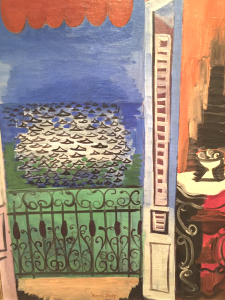
Raoul Dufy, The Window at Nice, 1923, Oil on canvas, Promised Gift of Mrs. Frederick Stafford, EL.1977.15
Raoul Dufy, The Window at Nice, 1923
A truly transportive piece, The Window at Nice by Raoul Dufy (1877–1953) immediately delivers its viewer to the French Riviera. Using a combination of Fauvism and Cubism styles, Dufy’s use of bright colors and bold patterns is a hallmark of his time. In 1937, Dufy undertook one of the largest painting commissions of his time, La Fée Electricité (The Spirit of Electrify), a fresco measuring more than 2,000 square feet at the entrance to the Pavilion of Light and Electricity at the International Exposition. Critics have often deemed Dufy’s works as frivolous and hedonistic, but his masterful use of color and lightness of touch led acclaimed novelist and friend Gertrude Stein to declare, “Raoul Dufy is pleasure itself’.”
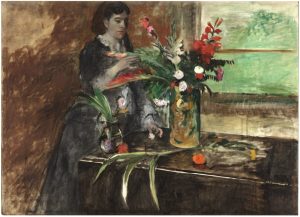
Edgar Degas, Portrait of Estelle Musson Degas, 1872, Oil on canvas, Museum Purchase through Public Subscription, 65.1
Edgar Degas, Portrait of Estelle Musson Degas, 1872
The only French Impressionist painter to travel to the United States, Edgar Degas (1834–1917) spent five months in New Orleans in 1872 visiting family. During his time in the city, he witnessed the loss of French culture in the city as it was replaced by American “settlers.” This portrait of his blind sister-in-law, Estelle, captures the deterioration of the French-speaking Creole way of life. In 1964 NOMA director James Byrne launched a successful “Bring Estelle Home” fundraising campaign for the purchase of the painting which as acquired for $190,000. The community-wide effort included a telethon and pocket-change canisters in schools.
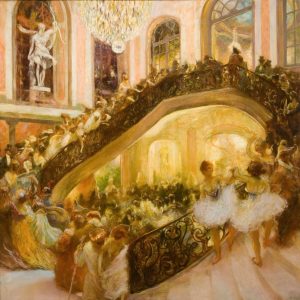
Gaston LaTouche, The Masquerade Ball — Grand Opera House, Paris, 19th/20th Century, Oil on canvas, Gift of Mr. Chapman H. Hyams, 16.1
Gaston LaTouche, The Masquerade Ball, 19th/20th Century
The sweeping vision of a masquerade ball in Paris’ Grand Opera House by Gaston Larouche (1854–1913) is as captivating as it is beautiful. Opera in Paris is an important art, both historically and culturally; the Paris Opera gave rise to the Classical style of ballet that would captivate French artists for years to follow. The scene depicts the crowded hall filled with costumed actors and lavish patrons, ascending and descending the opulent stairs. LaTouche met novelist and playwright Émile Zola at the Café de la Nouvelle Athens—a bohemian haunt that drew the likes of Henri Matisse, Vincent Van Gogh and Edgar Degas—and would go on to illustrate many of his published works.
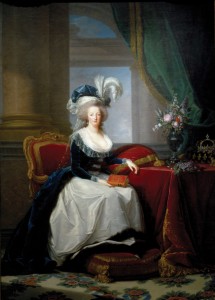
Elisabeth Louise Vigée Le Brun, Portrait of Marie Antoinette, Queen of France, c. 1788, Oil on canvas, Museum Purchase: Women’s Volunteer Committee and Carrie Heiderich Fund, 85.90
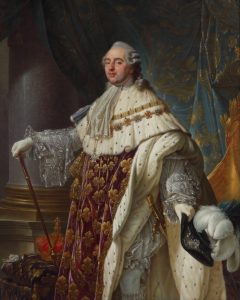
Antoine Francois Callet, Portrait of Louis XVI, c. 1782–1783, Oil on canvas, Museum Purchase in honor of the 75h anniversary, 86.90
Elisabeth Louise Vigée Le Brun, Portrait of Marie Antoinette, Queen of France, c. 1788, and Antoine François Callet, Portrait of Louis XVI, c. 1782-1783
A truly breathtaking piece, both in its scale and subject, the Portrait of Marie Antoinette, Queen of France captures the luxurious lifestyle of the French royalty pre-Revolution. The magnificence of the commissioned painting pleased the Queen, and Elisabeth Louise Vigée Le Brun (1755–1842) was awarded membership in the Académie Royale and continued royal patronage, a rare accomplishment for a woman of the 18th century. Following the revolution, Le Brun was forced into exile in Italy since she faced danger having been a close associate of the royal family. Nearby is lavish portrait of King Louis XVI, painted by Antoine François Callet only a few years prior to the French Revolution. Notorious for their excess, the royal couple are immortalized in these paintings that portray the opulent—and ultimately fatal—lifestyle of the last monarchs of France.
NOMA intern Katelyn Fecteau contributed to this list.